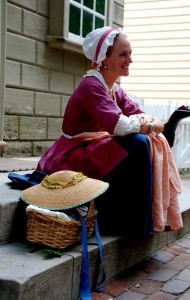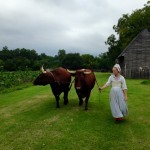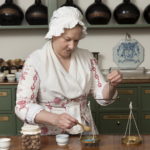After giving birth to my first child Deirdre, my obstetrician revealed that I almost died in the process. I hemorrhaged quite a bit and unbeknownst to me, when my firstborn decided to enter the world sunny-side up (babies are usually born head down), she fractured my pelvic bones. Six weeks later, I still couldn’t walk. Thanks to the amazing care of my obstetrician, Dr. Jawwad Khan (who was most certainly a midwife in a past life), I had a full recovery.
It was around that time, while working on my degrees at Christopher Newport University, that I first learned about Martha Ballard, a midwife who practiced in the backwoods of Maine before, during, and after the Revolutionary War. I immediately connected with her story due to my traumatic birth experience which naturally piqued my curiosity about midwifery. That journey eventually evolved into one of my capstone research papers on midwifery and domestic arts in the colonial period.
For those who are unfamiliar with the term, “midwifery” is the practice of ensuring the safe and healthy delivery of the infant and placenta. Additionally, a midwife tends to the general health and well-being of the mother during her pregnancy and postpartum period. Throughout most of recorded history, midwifery was a profession dominated by women. One of the earliest recorded mentions of midwifery as a female profession is the Ebers Papyrus dated between 1900-1550 BCE. Pliny the Elder records in his tomes the names and medical knowledge of well-known midwives during the first century. Soranus of Ephesus, a Greek physician, also writes during that period about the qualities which make a woman a “good midwife”:
She must have her wits about her so that she may easily follow what is said and what is happening… To obtain good midwifery habits, she will be well disciplined and always sober… keeping her hands soft by avoiding wool-working as this may harden her hands and may not be handicapped in the performance of her work.
During the European witch craze, which raged from the 14th to 17th century, midwives were one of the vulnerable groups of women plagued by accusations. Here in the colony of Virginia, we also felt the reverberations of the witch hunts. In 1626, widow Joan Wright of Surry County was accused by her neighbors of witchcraft after years of successful midwifery service.
Most of what we know about 18th-century midwives comes from journals, letters, and newspaper articles from the period. There are also a few books and manuals written during the 1700s by doctors for midwives. Two sold in Williamsburg were Nicholas Culpeper’s A Directory for Midwives and Dr. John Memis’s The Midwife’s Pocket-Companion.
Many midwives gained their training and experience by successfully assisting in a number of births, thus building a reputation. Although Mary Cooper of Long Island, for example, was not formally trained as a midwife, she attended and assisted in enough births that she was called upon to help and given payment in various forms for that assistance.
Martha Ballard was the niece of physicians and also gained her skills in midwifery through hands-on experience. She was extremely skilled and had a very low maternal and infant mortality rate for the period. Ballard also tended the ill and made folk remedies for her patients. She recorded her payment for her services, usually “in food, textiles, or household necessities,” and her midwifery practice was quite successful. In addition to their professions, both Mary and Martha were farm wives and recorded a number of the other familial and domestic duties in their diaries.
Catherine Kaidyee Blaikley was an “eminent midwife here in Williamsburg. During her 35-plus years practicing, she delivered “upwards of 3,000 children,” which at the time was almost double the population of the colonial capital. She began her practice after she was widowed. It appears she did well for herself, judging by the possessions she acquired after her husband’s death. One such item is her beautiful Book of Common Prayer, which is bound in red leather and sometimes on display at the Art Museums of Colonial Williamsburg. Upon her death in 1771, a notice was printed in the Gazette praising her life and services. She was buried in Bruton Parish courtyard.
Midwives held an esteemed place within their communities, demonstrated by the fact that they were sometimes called into court to testify to paternity, the age of the accused, to examine child deaths, determine pregnancy, and verify domestic or sexual abuse. An example of the latter case occurred in Virginia in 1646, when Ann Owle accused her husband of abuse “in such a secrett manner that it is not fitt to be discust by the court publiquely” after giving birth a few days earlier. The justices called upon the midwife, Margaret Grimes, to verify her account.
The practice of midwifery was not limited to white women. York County records include two 18th-century references to free African American women, Mary Roberts and Elizabeth Armfield, serving as midwives.
A steady rise in man-midwives began in the 18th century. In Williamsburg alone John Galt, George Gilmer, Jr., Andrew Anderson, and Peter Hay all advertised their services. At first it wasn’t universally accepted. Many vehemently objected to the practice here in Virginia. On October 1st, 1772 a “Letter on the Present State of Midwifery” published in Purdie and Dixon’s Virginia Gazette questioned the propriety of using men as midwives.
The use of man-midwives and physicians continued to grow into the 19th century. Although male physicians (and later, obstetricians) eventually dominated the field, the influence of midwives can still be found socially and culturally today. Colonial midwives brought thousands of lives into this world, and their legacy is evident in the resurgence of the practice of professional midwifery in the United States. One of the leaders in this field is Ina May Gaskin. There also are now a growing number of college programs to be become certified nurse midwifes and a resurgence of interest steadily growing more traditional birth experiences.
Personally, studying historic midwifery had a profound effect on my subsequent pregnancies. After Deirdre, I was blessed to go on to deliver two more healthy babies with my best friend and my doula (a non-medical support person who emotionally assists and coaches a woman through childbirth) by my side. My choice to have a doula present was due to wanting to feel more supported during childbirth, just as most women did in the 18th century. I’d be lying if I said I wasn’t scared each time. Scared about my health and the health of my babies. Childbirth, and child rearing for that matter, is no easy task.
If you’d like to learn more about 18th-century midwifery or obstetrics, please stop by the Apothecary here in Colonial Williamsburg. Both Robin and Sharon are experts. And even though I’m working at he Candlemakers right now, I’m happy to talk about these amazing women, so please pay me a visit! We’re located behind the Joiner Shop!
GUEST BLOGGER: NICOLE JUSTICE GREEN
 Nicole is an Orientation Interpreter and native Virginian who has been with the Foundation since May 2014. Her mother always told her she’d end up working for Colonial Williamsburg one day despite Nicole’s protestations. (Mothers are always right!) Before she came to Colonial Williamsburg, Nicole stayed home with her children and kept a hobby farm for five years after graduating with degrees in History and Teaching from Christopher Newport University.
Nicole is an Orientation Interpreter and native Virginian who has been with the Foundation since May 2014. Her mother always told her she’d end up working for Colonial Williamsburg one day despite Nicole’s protestations. (Mothers are always right!) Before she came to Colonial Williamsburg, Nicole stayed home with her children and kept a hobby farm for five years after graduating with degrees in History and Teaching from Christopher Newport University.
She and her husband Cameron live in the Greenbelt of the Historic Area with their three kids Deirdre, Jonas, and Brynna. Besides being obsessed with chickens Nicole loves to surf, paint, and visit historic sites with her husband. She’d rather give away her right hand than be parted from her history books. But if you ask nicely she’ll happily lend you one.



What a loss to the Foundation! To think that a child care in Williamsburg cost almost as much as her weekly wage- you are doing your employees a great disservice by paying them such meager wages and are driving away your most dedicated and loved employees. She will be missed by her colleagues and guests alike.
Gina says
Great stuff! Thanks for posting!
How very interesting. Colonial Williamsburg’s answer to the BBC series “Call the Midwie”, set in the late 50’s/eaerly 60’s. Thank you.
There was also an interesting British series called “William & Mary” about the a modern midwife (Julie Graham) and her boyfriend (Martin Clunes), who happened to be an undertaker The series implied that midwives are still fairly common in Great Britain.
Annie says
Here in the UK, every pregnant woman is assigned or chooses a midwife once pregnancy is confirmed. I’m surprised to learn this is apparently not the case in the US.
J.F. Thompson says
This area is one of my chief interests as well. I would love to be able to read your research paper!